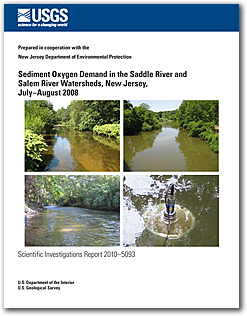Scientific Investigations Report 2010–5093
ABSTRACT
Many factors, such as river depth and velocity, biochemical oxygen demand, and algal productivity, as well as sediment oxygen demand, can affect the concentration of dissolved oxygen in the water column. Measurements of sediment oxygen demand, in conjunction with those of other water-column water-quality constituents, are useful for quantifying the mechanisms that affect in-stream dissolved-oxygen concentrations. Sediment-oxygen-demand rates are also needed to develop and calibrate a water-quality model being developed for the Saddle River and Salem River Basins in New Jersey to predict dissolved-oxygen concentrations. This report documents the methods used to measure sediment oxygen demand in the Saddle River and Salem River watersheds along with the rates of sediment oxygen demand that were obtained during this investigation. In July and August 2008, sediment oxygen demand was measured in situ in the Saddle River and Salem River watersheds. In the Saddle River Basin, sediment oxygen demand was measured twice at two sites and once at a third location; in the Salem River Basin, sediment oxygen demand was measured three times at two sites and once at a third location. In situ measurements of sediment oxygen demand in the Saddle River and Salem River watersheds ranged from 0.8 to 1.4 g/m2d (grams per square meter per day) and from 0.6 to 7.1 g/m2d at 20 degrees Celsius, respectively. Except at one site in this study, rates of sediment oxygen demand generally were low. The highest rate of sediment oxygen demand measured during this investigation, 7.1 g/m2d, which occurred at Courses Landing in the Salem River Basin, may be attributable to the consumption of oxygen by a large amount of organic matter (54 grams per kilogram as organic carbon) in the streambed sediments or to potential error during data collection. In general, sediment oxygen demand increased with the concentration of organic carbon in the streambed sediments. Repeated measurements made 6 to 7 days apart at the same site locations resulted in similar values. |
First posted July 16, 2010 For additional information contact: Part or all of this report is presented in Portable Document Format (PDF); the latest version of Adobe Reader or similar software is required to view it. Download the latest version of Adobe Reader, free of charge. |
Heckathorn, H.A., and Gibs, J., 2010, Sediment oxygen demand in the Saddle River and Salem River watersheds, New Jersey, July–August 2008: U.S. Geological Survey Scientific Investigations Report 2010–5093, 10 p.
Acknowledgments
Abstract
Introduction
Purpose and Scope
Study Areas
Methods and Procedures
Study Design
Sediment Oxygen Demand Chambers
Sediment Oxygen Demand Chamber Deployments
Calculation of Sediment Oxygen Demand
Sediment Oxygen Demand in the Saddle River and Salem River Watersheds
Rates of Sediment Oxygen Demand
Factors Affecting Sediment Oxygen Demand
Composition of Streambed Material and Streamflow Regime
Water-Column Oxygen Demand
Summary
References Cited